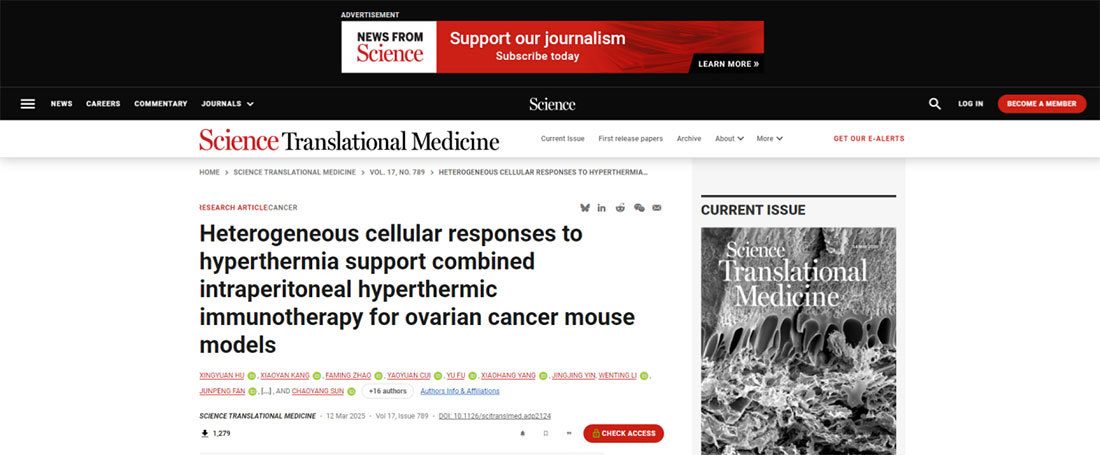Science Translational Medicine research paper: Hyperthermia reshapes the tumor microenvironment and proposes a new strategy for combined treatment of ovarian cancer
Hyperthermic intraperitoneal chemotherapy (HIPEC) has been used to treat gastric cancer, but its efficacy in patients with peritoneal metastasis of ovarian cancer remains unclear, hindering the development of rational combination therapies based on hyperthermia (HT).
Release time:
2025-07-09
Source:

Hyperthermic Intraperitoneal Chemotherapy (HIPEC) has been used to treat gastric cancer, but its efficacy in patients with peritoneal metastasis of ovarian cancer remains unclear, hindering the development of rational combination therapies based on hyperthermia (HT).
On March 13, 2025, a research team led by Professor Sun Zhaoyang and Professor Chen Gang from Tongji Hospital affiliated with Tongji Medical College, Huazhong University of Science and Technology, in collaboration with Professor Li Jing from Sun Yat-sen Memorial Hospital of Sun Yat-sen University, Professor Zhou Xin from Shengjing Hospital affiliated with China Medical University, and Professor Sheng Xia from Hainan University, published a research paper titled "Heterogeneous cellular responses to hyperthermia support combined intraperitoneal hyperthermic immunotherapy for ovarian cancer mouse models" in Science Translational Medicine, a sub-journal of Science.
In this phase 2 clinical trial, the research team evaluated the effects of pre-operative HIPEC in ovarian cancer patients and the changes in tumors before and after treatment. The team observed improvements in the immunosuppressive tumor microenvironment (TME) during treatment and confirmed in mouse models that the combination of HIPEC and immunotherapy (PD-1 monoclonal antibody) improved treatment efficacy.
These findings provide promising evidence that combining immunotherapy with HIPEC may further improve the prognosis of ovarian cancer patients.
This study reports preliminary results from a neoadjuvant HIPEC (NHIPEC) clinical trial, indicating that the application of NHIPEC in high-grade serous ovarian cancer can enhance tumor response.
Through single-cell RNA sequencing analysis, the research team found cells with both consistent and inconsistent responses to hyperthermia (HT) in both the tumor and microenvironment. Epithelial-mesenchymal transition-activated tumor cells and matrix metalloproteinase 11 (MMP-11)-positive cancer-associated fibroblasts (CAFs) showed greater reduction and higher sensitivity to hyperthermia.
Integration of CUT&Tag and RNA sequencing revealed differential binding patterns and transcriptional regulation mechanisms of heat shock factor-1 (HSF1) in tumor cells and cancer-associated fibroblasts under normothermic and hyperthermic conditions. Furthermore, hyperthermia improved the immunosuppressive tumor microenvironment, and in vivo mouse models confirmed the anti-tumor effect of combined hyperthermia and PD-1 antibody treatment.
These findings provide innovative strategies for rational combination therapy of ovarian cancer, suggesting that combining immunotherapy with HIPEC may further improve the prognosis of ovarian cancer patients.
Original link: https://www.science.org/doi/10.1126/scitranslmed.adp2124



